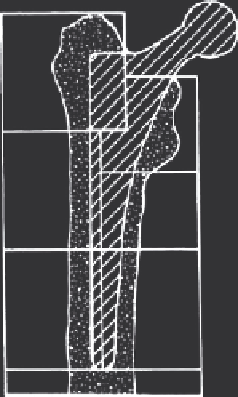Biomedical Engineering Reference
In-Depth Information
1
7
2
6
3
5
4
FIGURE 8.8
Schematic representation of a femur implanted with a hip prosthesis [56].
In analyzing the densitometry findings, Dallari et al. subtracted for each
area the postoperative DXA values from those measured at 90 days and
considered all results above 3.5% as responders; this value was selected
on the basis of the coefficient of variation of Eclipse (3%) for this type of
investigation.
8.5.3
PEMF Stimulation
Dallari et al. [56] started stimulation within 7 days of the operation and
maintained it up to day 90. The subjects were instructed to use the devices
for at least 6 hours per day. All the stimulators were equipped with a timer to
record the hours of use. The electromagnetic field was generated by a single
coil that was positioned on the lateral surface of the thigh and kept in place
by a Velcro strap. The pulse generator supplied the coil with single voltage
pulses at 75 Hz, each lasting 1.3 ms. The peak amplitude of magnetic field
was 2 ± 0.2 mT. This measurement was made by the Hall probe of the gauss-
meter [56]. The peak voltage in a coil probe connected to a Tektronix 720A
oscilloscope was 2.5 ± 0.2 mV. Since the coil probe consisted of 50 turns and
was of 0.5 cm internal diameter, this corresponded to a dB/dt max value of
2.5 T/s.
8.5.4
Discussion
In Dallari et al. [56], PEMF stimulation was applied in humans to enhance
the outcome of hip arthroplasty as it can influence a relatively large area

